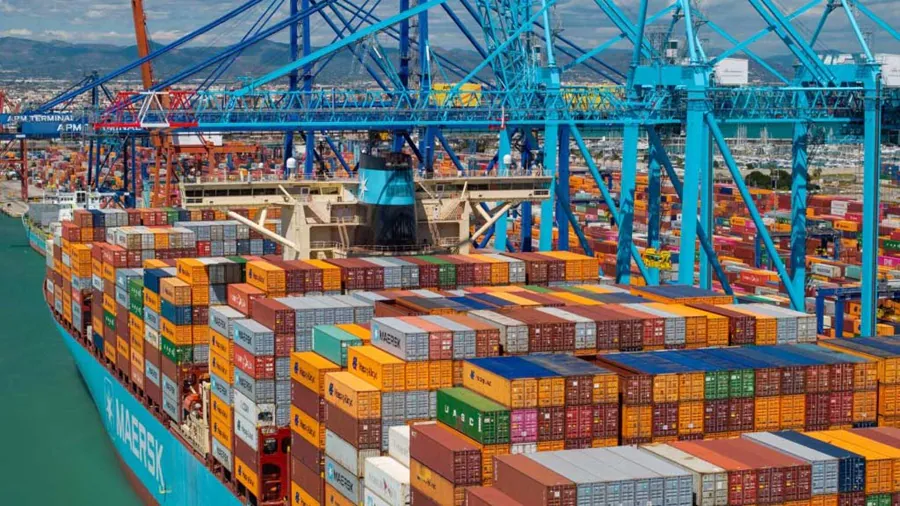
Maersk Asia Pacific Market Update – May 2025
COPENHAGEN : As we move further into 2025, the Asia Pacific logistics landscape continues to be shaped by geopolitical developments, evolving trade policies, and shifting demand patterns. While ocean and air freight volumes remained resilient in early Q1, new tariff regimes and market uncertainty are beginning to reshape customer behaviour and cargo flows. At Maersk, we remain focused on helping our customers navigate these complexities with agility, transparency, and integrated solutions across ocean, air, inland, and Customs. This month’s update provides the latest insights across key transport modes, spotlighting the impact of current policy shifts and outlining how we’re supporting customers in building more flexible, resilient supply chains.
Ocean Market Update
Global Ocean Container Trade Maintained Solid momentum in Q1
A large container ship rests at the dock, surrounded by cranes and stacks of cargo containers at the port.
Global ocean container trade maintained solid momentum , with volumes growing 4.7% year- on-year between December and February, according to Maersk Strategic Insight. Far East Asia remained a key driver of growth, with sus- tained export activity supporting higher import volumes into Latin America, Europe, and North America. In contrast, imports into Far East Asia declined by 7.4%, reflecting post–Lunar New Year softness and a continued drawdown of existing inventories. Despite seasonal easing in March, export flows from Asia to the U.S. and Europe remained steady, though the overall environment has become more complex.
Amid Shifting Market Dynamics, Maersk remains committed to maintaining a stable and reliable schedule for our customers
The volatility and complexity of the shifting policy landscape places global logistics at the forefront as the effects of trade tensions reinforces the importance of agile and robust supply chains. We are in close contact with our customers navigating a volatile and uncertain business landscape. Many deploy a “wait and see” approach, keeping goods flowing as they work to clarify options to respond and mitigate based on a range of scenarios. Uncertainty remains the key challenge and until there is a clearer picture, we expect customers to be more cautious about their inventory levels and continue exploring ways to build additional flexibility into their supply chains.
Recent months have also seen an increased number of cancelled sailings on the Transpacific trade. According to Sea-Intelligence, the overall deployed capacity on Transpacific routes has already been reduced by 19% as of date and may accelerate further in the coming weeks.
Amid shifting market dynamics, Maersk remains committed to maintaining a stable and reliable schedule for our customers.
In a time of heightened uncertainty, maintaining a predictable and dependable network is critical for our customers’ supply chain planning. Maersk has to date prioritized operating a full sailing program on the Transpacific corridor, while we in some cases sail smaller vessels to release the larger ones for trades with higher demand
Dennis Bøttern Bai, Regional Head of Transpacific and Asia-Latin America for Maersk
Despite the market experiencing adjusted schedules and blanked sailings, Maersk to date has maintained a full sailing schedule across the Transpacific corridor, prioritizing reliability and resilience for customers. Our newly launched East-West network combines mainliner strength with shuttle agility, ensuring consistent and dependable services across Asia Pacific even amid ongoing volatility.
The impact of new tariffs will increasingly shape the outlook for the Intra-Asia market, which experienced strong demand through the first quarter of 2025. These tariffs may affect the movement of raw materials and semi-finished goods destined for re-export to global markets. Maersk is actively monitoring these developments and maintaining flexibility in our network to respond quickly to shifting trade patterns.
Update on Schedule Reliability from Sea-Intelligence
We’ve achieved 90.3% schedule reliability in March, according to Sea-Intelligence – a strong milestone in the phase-in of our East-West Network under the Gemini Cooperation. We’re continuing to improve service reliability and efficiency for our customers.
Here’s what we’ve achieved so far:
Network phase-in: All exports in each respective regions are now running on the new network.
Continued reliability above 90%: We deliver towards our goal of schedule reliability above 90% once our network is fully phased in by June.
Fleet Transition: Around 95% of the 340 vessels have joined the new network, and we’re on track to complete the full phase-in by mid-May 2025.
Update on the USTR Section 301 review
On April 17, 2025, the United States Trade Representative (USTR) concluded its Section 301 investigation into China’s maritime, logistics, and shipbuilding sectors. As a result, the U.S. government will begin phasing in higher fees on Chinese-owned and Chinese-built vessels calling U.S. ports. While the rule takes effect immediately, fees are set at $0 for the first 180 days and will begin increasing from October 14, 2025.
At this time, we do not see a direct cost from this initiative impacting Maersk or our customers. We do not anticipate changes to our U.S. port rotations due to the new fees. Your current service plans remain unchanged.
We are monitoring developments closely and will keep you informed. Thank you for your support of our services and please contact your Maersk representative if you require additional information. We’re here to help you plan ahead.
